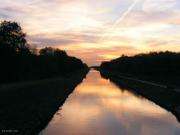June 29, 2011 report
Prehistoric BBQ has bone marrow and aurochs on the menu

(PhysOrg.com) -- In the July issue of the Journal of Archaeological Science, researchers reveal the prehistoric remains of a BBQ in the valley of the River Tjonger in the Netherlands that took place over 7,700 years ago.
The find provided direct evidence of hunting, butchering, cooking and feasting all taking place in one location. The researchers, Wietske Prummel and Marcel Niekus from the University of Groningen, believe that the animal, an auroch or wild ox slightly larger than modern day cows, was either beaten and clubbed in the head after falling in a pitfall trap or shot with a bow and arrow.
The find then shows the hunter used a flint blade to cut the leg bones of the animal and suck out the bone marrow. It appears that the hunter then cooked up the ribs and other small pieces to eat right there on the spot. Prummel believes this immediate consumption of part of the kill may have been a reward for a successful hunt.
The hunter then used the flint blade to meticulously separate all the meat from the bones in order to transport it to a nearby settlement. They believe the hunters reserved the large chunks of meat and skin for to take back to the group.
This hunter is believed to have lived during the Late Mesolithic period and some 1,000 years before the first farmers moved into this region for farming and to raise their domesticated cattle. It was this move of farmers to the region that inevitably killed off the auroch.
The aurochs were a large source of food for hunters given their large size and a few other sites have revealed their bones and evidence of butchering. However, killing these large animals could not have been easy and could be one reason that elk and deer bones are a more common find. Another site in Onnarp, Sweden had discovered auroch remains that showed evidence of arrows and being shot, but not of butchering. It was believed that these animals were hit by the hunters, but only wounded and ran off before eventually dying.
The aurochs did eventually fall victim to extinction in 1627 when the last surviving auroch died in a Poland zoo.
More information: Late Mesolithic hunting of a small female aurochs in the valley of the River Tjonger (the Netherlands) in the light of Mesolithic aurochs hunting in NW Europe, Journal of Archaeological Science, Volume 38, Issue 7, July 2011, Pages 1456-1467. doi:10.1016/j.jas.2011.02.009
Abstract
The valley of the River Tjonger, situated in the Province of Friesland (the Netherlands), is rich in prehistoric organic remains. The fill of the valley, consisting of waterlogged sediments (peat, gyttja and sands), presents favourable conditions for the preservation of bone, antler and botanical remains. Numerous bones with chop and cut marks, in majority of aurochs (Bos primigenius), are known from several locations in the valley. The Late Mesolithic (ca. 8000–5500 BP) is especially well represented. In this paper we present a recently discovered small hunting and butchering wetland site dating to the Late Mesolithic. The site, named Balkweg, represents a single hunting and primary butchering event pertaining to a small female aurochs with a height at the withers of 134 cm. The morphology of the vertebrae and the phalanges as well as the Late Mesolithic date confirm the identification as an aurochs cow. Single event sites are underrepresented in the archaeological record due to their small size and poor visibility. The importance of aurochs hunting during the Mesolithic is discussed in this paper as well.
© 2010 PhysOrg.com


















